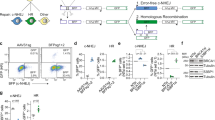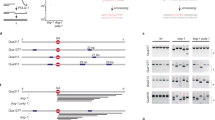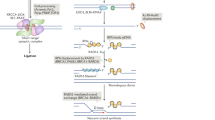Abstract
DNA double-strand breaks (DSBs), the most hazardous DNA lesions, may result in genomic instability, a hallmark of cancer cells. The main DSB repair pathways are non-homologous end joining (NHEJ) and homologous recombination (HR). In mammalian cells, NHEJ, which can lead to inaccurate repair, predominates. HR repair (HRR) is considered accurate and is restricted to S, G2 and M phases of the cell cycle. Despite its importance, many aspects regarding HRR remain unknown. Here, we developed a novel inducible on/off switch cell system that enables, for the first time, to induce a DSB in a rapid and reversible manner in human cells. By limiting the duration of DSB induction, we found that non-persistent endonuclease-induced DSBs are rarely repaired by HR, whereas persistent DSBs result in the published HRR frequencies (non-significant HR frequency versus frequency of ∼10%, respectively). We demonstrate that these DSBs are repaired by an accurate repair mechanism, which is distinguished from HRR (most likely, error-free NHEJ). Notably, our data reveal that HRR frequencies of endonuclease-induced DSBs in human cells are >10-fold lower than what was previously estimated by prevailing methods, which resulted in recurrent DSB formation. Our findings suggest a role for HRR mainly in repairing challenging DSBs, in contrast to uncomplicated lesions that are frequently repaired by NHEJ. Preventing HR from repairing DSBs in the complex and repetitive human genome probably has an essential role in maintaining genomic stability.
This is a preview of subscription content, access via your institution
Access options
Subscribe to this journal
Receive 50 print issues and online access
$259.00 per year
only $5.18 per issue
Buy this article
- Purchase on Springer Link
- Instant access to full article PDF
Prices may be subject to local taxes which are calculated during checkout





Similar content being viewed by others
References
Barlow JH, Lisby M, Rothstein R . (2008). Differential regulation of the cellular response to DNA double-strand breaks in G1. Mol Cell 30: 73–85.
Bennardo N, Gunn A, Cheng A, Hasty P, Stark JM . (2009). Limiting the persistence of a chromosome break diminishes its mutagenic potential. PLoS Genet 5: e1000683.
Brandeis M, Hunt T . (1996). The proteolysis of mitotic cyclins in mammalian cells persists from the end of mitosis until the onset of S phase. EMBO J 15: 5280–5289.
Chang DC, Xu N, Luo KQ . (2003). Degradation of cyclin B is required for the onset of anaphase in Mammalian cells. J Biol Chem 278: 37865–37873.
Covo S, de Villartay JP, Jeggo PA, Livneh Z . (2009). Translesion DNA synthesis-assisted non-homologous end-joining of complex double-strand breaks prevents loss of DNA sequences in mammalian cells. Nucleic Acids Res 37: 6737–6745.
Fung TK, Poon RY . (2005). A roller coaster ride with the mitotic cyclins. Semin Cell Dev Biol 16: 335–342.
Hartlerode AJ, Scully R . (2009). Mechanisms of double-strand break repair in somatic mammalian cells. Biochem J 423: 157–168.
Honma M, Sakuraba M, Koizumi T, Takashima Y, Sakamoto H, Hayashi M . (2007). Non-homologous end-joining for repairing I-SceI-induced DNA double strand breaks in human cells. DNA Repair (Amst) 6: 781–788.
Jeggo PA . (1998). DNA breakage and repair. Adv Genet 38: 185–218.
Lukusa T, Fryns JP . (2008). Human chromosome fragility. Biochim Biophys Acta 1779: 3–16.
Mao Z, Bozzella M, Seluanov A, Gorbunova V . (2008). DNA repair by nonhomologous end joining and homologous recombination during cell cycle in human cells. Cell Cycle 7: 2902–2906.
Moffat J, Grueneberg DA, Yang X, Kim SY, Kloepfer AM, Hinkle G et al. (2006). A lentiviral RNAi library for human and mouse genes applied to an arrayed viral high-content screen. Cell 124: 1283–1298.
Nakanishi K, Yang YG, Pierce AJ, Taniguchi T, Digweed M, D'Andrea AD et al. (2005). Human Fanconi anemia monoubiquitination pathway promotes homologous DNA repair. Proc Natl Acad Sci USA 102: 1110–1115.
Pierce AJ, Johnson RD, Thompson LH, Jasin M . (1999). XRCC3 promotes homology-directed repair of DNA damage in mammalian cells. Genes Dev 13: 2633–2638.
Rothkamm K, Kruger I, Thompson LH, Lobrich M . (2003). Pathways of DNA double-strand break repair during the mammalian cell cycle. Mol Cell Biol 23: 5706–5715.
Saleh-Gohari N, Helleday T . (2004). Conservative homologous recombination preferentially repairs DNA double-strand breaks in the S phase of the cell cycle in human cells. Nucleic Acids Res 32: 3683–3688.
Salpeter SJ, Klochendler A, Weinberg-Corem N, Porat S, Granot Z, Shapiro AM et al. (2011). Glucose regulates cyclin D2 expression in quiescent and replicating pancreatic β-cells through glycolysis and calcium channels. Endocrinology 152: 2589–2598.
Sartori AA, Lukas C, Coates J, Mistrik M, Fu S, Bartek J et al. (2007). Human CtIP promotes DNA end resection. Nature 450: 509–514.
Schaaf MJ, Cidlowski JA . (2003). Molecular determinants of glucocorticoid receptor mobility in living cells: the importance of ligand affinity. Mol Cell Biol 23: 1922–1934.
Schwartz M, Zlotorynski E, Goldberg M, Ozeri E, Rahat A, le Sage C et al. (2005). Homologous recombination and nonhomologous end-joining repair pathways regulate fragile site stability. Genes Dev 19: 2715–2726.
Shibata A, Conrad S, Birraux J, Geuting V, Barton O, Ismail A et al. (2011). Factors determining DNA double-strand break repair pathway choice in G2 phase. EMBO J 30: 1079–1092.
Shrivastav M, De Haro LP, Nickoloff JA . (2008). Regulation of DNA double-strand break repair pathway choice. Cell Res 18: 134–147.
Soutoglou E, Dorn JF, Sengupta K, Jasin M, Nussenzweig A, Ried T et al. (2007). Positional stability of single double-strand breaks in mammalian cells. Nat Cell Biol 9: 675–682.
Takashima Y, Sakuraba M, Koizumi T, Sakamoto H, Hayashi M, Honma M . (2009). Dependence of DNA double strand break repair pathways on cell cycle phase in human lymphoblastoid cells. Environ Mol Mutagen 50: 815–822.
Takata M, Sasaki MS, Sonoda E, Morrison C, Hashimoto M, Utsumi H et al. (1998). Homologous recombination and non-homologous end-joining pathways of DNA double-strand break repair have overlapping roles in the maintenance of chromosomal integrity in vertebrate cells. EMBO J 17: 5497–5508.
Villalobos MJ, Betti CJ, Vaughan AT . (2006). Detection of DNA double-strand breaks and chromosome translocations using ligation-mediated PCR and inverse PCR. Methods Mol Biol 314: 109–121.
Wersto RP, Chrest FJ, Leary JF, Morris C, Stetler-Stevenson MA, Gabrielson E . (2001). Doublet discrimination in DNA cell-cycle analysis. Cytometry 46: 296–306.
Yanez RJ, Porter AC . (1998). Therapeutic gene targeting. Gene Ther 5: 149–159.
Zur A, Brandeis M . (2001). Securin degradation is mediated by fzy and fzr, and is required for complete chromatid separation but not for cytokinesis. EMBO J 20: 792–801.
Acknowledgements
We thank members of our laboratories, Sagiv Shifman and Liran Carmel for discussions, Naomi Melamed-Book for assistance in confocal analyses, Maya Schuldiner and Yifat Cohen for technical help. Stephan P Jackson, Tom Misteli, Amir Eden and Agnes Klochendler-Yeivin for reagents, Ilana Livyatan for critical reading of the manuscript, Evi Soutoglou for discussions and reagents, and the Edmond J Safra Foundation for financial support. MG is supported by the AFHU, The United States Binational Science Foundation (2009286) and the Israel Cancer Association. EM is a Joseph H and Belle R Braun senior lecturer in life sciences and is supported by the Israel Science Foundation (943/09), the Israel Cancer Research Foundation, the Israel Ministry of Health (6007), the European Union (IRG-206872 and 238176), the Internal Applicable Medical Grants of the HU and the Israel Psychobiology Institute. EVSRR is supported by the Lady Davies Fellowship program.
Author information
Authors and Affiliations
Corresponding authors
Ethics declarations
Competing interests
The authors declare no conflict of interest.
Additional information
Supplementary Information accompanies the paper on the Oncogene website
Supplementary information
Rights and permissions
About this article
Cite this article
Shahar, O., Ram, E., Shimshoni, E. et al. Live imaging of induced and controlled DNA double-strand break formation reveals extremely low repair by homologous recombination in human cells. Oncogene 31, 3495–3504 (2012). https://doi.org/10.1038/onc.2011.516
Received:
Accepted:
Published:
Issue Date:
DOI: https://doi.org/10.1038/onc.2011.516
Keywords
This article is cited by
-
PARG deficiency is neither synthetic lethal with BRCA1 nor PTEN deficiency
Cancer Cell International (2016)
-
Generation of Human Embryonic Stem Cell Line Expressing zsGreen in Cholinergic Neurons Using CRISPR/Cas9 System
Neurochemical Research (2016)
-
Quantifying DNA double-strand breaks induced by site-specific endonucleases in living cells by ligation-mediated purification
Nature Protocols (2014)



